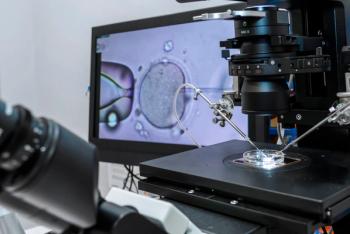
Recurrent pregnancy loss
Evidence on which to base management of RPL is limited, challenging ob/gyns with patients facing this stressful diagnosis.
Recurrent pregnancy loss (RPL) is defined as 2 or more consecutive failed pregnancies.1 Although sporadic pregnancy loss is relatively common, complicating up to 50% of pregnancies,2,3 only 5% of couples will be diagnosed with RPL.
There are many possible etiologies for both recurrent and sporadic pregnancy loss. The most common by far are genetic abnormalities (accounting for >50% of cases). Genetic abnormalities can reflect whole-chromosome abnormalities (trisomy, monosomy, triploidy, etc.), partial-chromosome abnormalities (eg, macro- and microdeletions and insertions, unbalanced translocations), single-gene disorders affecting exons, introns, and promoter regions, as well as micro-RNA defects and changes in gene function reflecting epigenetic changes.
Other putative causes of RPL include disorders of thrombosis and hemostasis, uterine anomalies, immunologic disease, endocrine diseases, infectious etiologies, and other factors including environmental influences such as cigarette smoking.3,4 The causes and workup of RPL differ widely depending on the gestational age of the loss.
Thus, it is helpful to consider losses as pre-embryonic (“chemical pregnancy” or anembryonic gestation detected by ultrasound), embryonic (<10 weeks’ gestation), or fetal (10 or more weeks’ gestation).5
The goal of this article is to provide a thorough but concise understanding of the etiologies of pregnancy loss, and strategies for evidence-based workup and treatment of couples with a diagnosis of RPL.
Genetic causes
Aneuploidy
Cytogenetic abnormalities such as trisomy, monosomy, and polyploidy are noted in 50%–60% of specimens obtained from first-trimester pregnancy losses.2,3 Some suspect the rate may be even higher, given the challenges of separating maternal decidua from products of conception, particularly at the earliest gestational ages.6,7 If there is maternal cell contamination, the euploid maternal cells can outgrow the aneuploid fetal cells in culture and the resulting 46, XX karyotype will reflect the maternal genotype, not that of the conceptus. This challenge can be overcome by using microarray rather than traditional karyotype, since microarray does not rely on cell culture.8-10 It is well established that the rates of aneuploidy increase with increasing maternal age.2,11 Observational studies have shown that increased consumption of folic acid in the periconceptional period may reduce this risk.12,13
Rates of whole chromosome abnormalities seen in pre-embryonic and embryonic gestations are listed in Table 1. The most common autosomal trisomy in early abortus specimens is trisomy 16. Chromosomal abnormalities have been reported as many as 90% of anembryonic gestations; this number decreases to 50% in the embryonic period, and to 30% in the early fetal period. Approximately 6%–12% of stillbirths beyond 20 weeks are associated with chromosomal abnormalities. At later gestational ages, the most common aneuploidies are trisomies 21, 18, and 13.2
Another cytogenetic abnormality associated with RPL is an unbalanced translocation. Approximately 3%–5% of couples with RPL will have one partner with an unbalanced translocation. This would be expected to lead to unbalanced translocation in up to 50% of offspring, leading to an increased risk of loss (Figure 1).
Single-gene disorders
The single-gene disorders associated with pregnancy loss are more closely associated with fetal than with embryonic loss. The hemoglobinopathies are one example. Alpha thalassemia is a genetic disorder in which the hemoglobin alpha chain is abnormally configured and does not function. There are 4 genes for the alpha chain within the human genome. If both members of a couple have 2 abnormal copies, and both of those abnormal copies reside on the same chromosome 16 (cis configuration) then 25% of their offspring will inherit only abnormal genes, and will suffer from Hemoglobin Bart’s, leading to fetal hydrops and death.
Other single-gene disorders include the multiple pterygium syndromes, which can be inherited in an autosomal-recessive or X-linked fashion, but in either case can result in mid-pregnancy fetal loss. Crotti et al. recently reported on an association between the genes linked to cardiac cycle QT prolongation and stillbirth.14 If losses occur most often in male fetuses, one must consider the possibility of an X-linked genetic disease such as Rett syndrome. This is not a comprehensive list; in general these disorders cause intermittent mid-gestational losses but may present as mid-pregnancy RPL.
Newer genetic technologies such as chromosomal microarray and whole-exome or whole-genome sequencing are demonstrating promise as tools for further investigation of causes of RPL. There have been reports of copy number variants representing small duplications or deletions, and their relationship to pregnancy loss.8,9
Abnormalities of coagulation
Hypercoagulable states
This is an area in which there was much interest, but a growing number of prospective cohort studies have failed to demonstrate an association between inherited thrombophilias such as Factor V Leiden, Prothrombin 20210A mutation, or MTHFR C766T mutation and RPL. Furthermore, studies of heparin to prevent such losses have not demonstrated benefit.15-17
Acquired thrombophilias, namely antiphospholipid antibody syndrome (APAS), have long been associated with RPL. Specific criteria exist for pregnancy-related diagnosis of APAS as well as for diagnosis in nonpregnant individuals related to thrombosis. When women meet both the clinical and laboratory criteria for APAS, treatment in the periconceptional period with heparin and aspirin has been shown to decrease the rate of pregnancy loss and adverse pregnancy outcome.18-20
Of note, the validity of including recurrent early (<10 week) miscarriage as an obstetric criterion for APAS has recently been called into question.21 Careful review of the literature that established this association reveals several methodological weaknesses. A task force has been assembled, and it is hoped that new information will be made publicly available in the near future.20
Bleeding disorders
Rare diseases such as dysfibrinogenemia and factor XIII deficiency have been associated with mid-pregnancy hemorrhagic pregnancy loss.22
Some case reports exist of improved pregnancy outcomes in affected women after treatment with exogenous fresh frozen plasma. The typical presentation is a history of abruption or heavy vaginal bleeding preceding the loss, and these women often have a family history supportive of the diagnosis of inherited bleeding disorder.
Uterine anomalies
Some authors have demonstrated an association between the presence of a uterine septum or bicornuate uterus and RPL.23 Others have demonstrated an association between uterine cavity-distorting leiomyomas or polyps and RPL.24 While this body of literature is small, observational, and subject to significant ascertainment bias, imaging of the uterus by sonohysterography or hysterosalpingogram is still a standard practice.
Removal of uterine septi, adhesions, submucous myomas, and polyps is recommended until randomized trials better inform clinical practice.
Immune causes
Many studies have attempted to describe the role of maternal and paternal immunity in establishment of pregnancy and in RPL.25 However, despite some initial small positive studies demonstrating various associations, attempts at immune suppression with steroids or IVIG have not yielded any improvement in the live birth rate.26
One immunologic process that can lead to recurrent pregnancy loss involves infiltration of the placenta by various types of maternal white blood cells.27,28 The resulting inflammatory process, known variously as chronic intervillositis, hystiocytic intervillositis, or villitis of unknown etiology, has been associated with recurrent fetal loss as well as severe fetal growth restriction and stillbirth in pregnancies that extend beyond the early fetal period.27,28 Although this is a rare condition (severe forms are seen in less than 1% of first-trimester placental specimens),28 evaluation of products of conception from pregnancy loss by an experienced pathologist may yield important diagnostic information.
Endocrine-related causes
Many endocrine-mediated diseases including overt hypothyroidism, polycystic ovary syndrome (PCOS), poorly controlled diabetes, and luteal phase defects have been implicated in RPL. Thyroid hormone is involved in trophoblast function. Similarly, progesterone is a critical component of the support of early pregnancy.
Treatment of subclinical hypothyroidism (ie, euthyroid women with thyroid peroxidase antibodies) to reduce rates of miscarriage was evaluated in a Cochrane review published in 2010.29 That analysis showed a nonsignificant trend toward fewer miscarriages with thyroid replacement therapy.
A meta-analysis of progesterone therapy among women with RPL (ie, 3 or more consecutive miscarriages; 4 trials, 225 women), demonstrated a statistically significant decrease in the rate of miscarriage in women treated with progesterone compared to placebo or no treatment (OR 0.39; 95% CI 0.21–0.72).30 However, these 4 studies were considered to be of low methodological quality. A recent multicenter, double-blind, placebo-controlled, randomized trial of high-dose (400 mg per day) vaginal progesterone therapy among women with unexplained recurrent miscarriage from around 6 weeks’ through 12 weeks’ gestation showed no significant increase in live birth rates (RR of 1.04; 95% CI: 0.94–1.15).31 Progesterone supplementation, therefore, does not appear to be beneficial after 5 weeks’ gestation, however, the data are insufficient to rule out a benefit of luteal phase therapy and treatment up to 6 weeks.
PCOS has been studied as a risk factor for RPL, with conflicting results.32,33 Newer data make this relationship less certain, particularly because the use of metformin in these patients does not reduce rates of pregnancy loss.34 Obesity has been independently associated with RPL,35,36 as has diabetes.32 Thus, common sense would suggest that these patients should optimize their body mass index and glucose control before conceiving to improve their likelihood of subsequent live birth.
Diagnostic workup
The most important component of the workup is a thorough history and physical exam, which may uncover clues to previously undiagnosed underlying disease. Following that, the workup should include the components listed in Table 2.
Management
Any issues that arise as a result of the analyses in Table 2 should be addressed. All patients with modifiable risk factors should be counseled appropriately. As noted, some observational data suggest that there is an association between obesity and pregnancy loss,35,36 although other studies have not confirmed this link.37 Given this putative link and the known deleterious effect of obesity on overall health, overweight and obese women should be counseled on weight loss and exercise. Similarly an association has been documented between cigarette smoking and pregnancy loss,38 and tobacco is a known carcinogen with multiple negative health effects. Women who smoke should be counseled at every visit on the importance of cessation.
Otherwise, women should consider starting folic acid supplementation (4 mg daily), because it has been demonstrated to decrease the risk of aneuploidy and subsequent pregnancy loss.12,13 Progesterone supplementation during the luteal phase and early pregnancy should be undertaken only after a discussion with the patient regarding its uncertain benefits. We recommend empiric treatment for women with recurrent pre-embryonic losses (eg, chemical pregnancies).
No data exist to support the use of heparin or aspirin outside of the context of APAS for the prevention of RPL. Screening for inherited thrombophilias is not indicated. The presence of mid-pregnancy hemorrhagic losses should prompt an evaluation for bleeding dyscrasias (eg, hypofibrinogenemia, dysfibrinogenemia, and factor XIII deficiency).
Summary
Recurrent pregnancy loss is a psychologically stressful diagnosis for couples, and in approximately 50% of cases, no cause will be found.2 The number of evidence-based practices available for guidance is limited. This confluence of factors presents a challenge for clinicians. However, in studies of interventions aimed at reducing rates of miscarriage in women with otherwise unexplained RPL, control groups experience a live birth rate of up to 87% with no intervention.39 Thus, one of the most significant things we can do when caring for these complex patients is to offer them emotional support and accurate information.
As more work is done in this emerging area of inquiry, we will be able to shed more light on this complex problem.
References
1. Practice Committee, American Society for Reproductive Medicine: Definitions of infertility and recurrent pregnancy loss. Fertil Steril. 2008; 90: S60.
2. Warren JE, Silver RM. Genetics of Pregnancy Loss. Clinical Obstetrics and Gynecology. 2008;51(1):84-95.
3. Rai R, Regan L: Recurrent miscarriage. Lancet. 2006;768 (9535):601-611.
4. Rink BD, Lockwood CJ. Recurrent Pregnancy Loss. In: Creasy RJ, ed. Creasy & Resnik’s Maternal-Fetal Medicine: Principles and Practice, 7th Ed. Philadelphia, PA: Elsevier; 2013: 707-718.
5. Silver RM, Branch DW, Goldenberg R, et al. Nomenclature for pregnancy outcomes: time for a change. Obstet Gynecol. 2011;118(6):1402-1408. PMID:22105271
6. Murugappan G, Gustin S, Lathi RB. Separation of miscarriage tissue from maternal decidua for chromosome analysis. Fertil Steril. 2014;102:e9-10.
7. Bell KA, Van Deerlin PG, Haddad BR, Feinberg RF. Cytogenetic diagnosis of “normal 46, XX” karyotypes in spontaneous abortions may be misleading. Fertil Steril 1999;71:334-341.
8. Romero ST, Geiersbach KB, Paxton CN, et al. Differentiation of genetic abnormalities in early pregnancy loss. Ultrasound Obstet Gynecol. 2015;45(1):89-94.
9. Dhillon RK, Hillman SC, Morris RK, et al. Additional information from chromosomal microarray analysis (CMA) over conventional karyotyping when diagnosing chromosomal abnormalities in miscarriage: a systematic review and meta-analysis. BJOG 2014;121:11-21.
10.Reddy UM, Page GP, Saade GR et al. Karyotype versus microarray testing for genetic abnormalities after stillbirth. N Engl J Med 2012;367:2185-2193.
11. Hassold T, Hunt P. To err (meiotically) is human: the genesis of human aneuploidy.Nat Rev Genet. 2001;2(4):280-291.
12.George L, Mills JL, Johansson ALV et al. Plasma folate levels and risk of spontaneous abortion. JAMA. 2002;288:1867-1873.
13. Gaskins AJ, Rich-Edwards JW, Hauser R. Maternal prepregnancy folate intake and risk of spontaneous abortion and stillbirth. Obstet Gynecol. 2014;124(1):23-31.
14. Crotti L, Tester DJ, White WM, et al. Long QT syndrome-associated mutations in intrauterine fetal death. JAMA. 2013;309(14):1473-1482.
15. The American College of Obstetricians and Gynecologists Practice Bulletin No. 138: Inherited thrombophilia in pregnancy. 2013.
16.Dizon-Townson D, Miller C, Sibai B, et al.: The relationship of the factor V Leiden mutation and pregnancy outcomes for mother and fetus. Obstet Gynecol. 2005;106:517-524.
17.Clark P, Walker ID, Govan L, et al. The GOAL study: a prospective examination of the impact of factor V Leiden and ABO(H) blood groups on haemorrhagic and thrombotic pregnancy outcomes. Br J Haematol. 2008;140:236-240.
18. Miyakis S, Lockshin MD, Atsumi T, et al. International consensus statement on an update of the classification criteria for definite antiphospholipid syndrome (APS). J Thromb Haemost. 2006;4(2):295-306.
19.Franklin RD, Kutteh WH: Antiphospholipid antibodies (APA) and recurrent pregnancy loss: treating a unique APA positive population. Hum Reprod. 2002;17(11):2981-2985.
20.Mak A, Cheung MW, Cheak AA, et al. Combination of heparin and aspirin is superior to aspirin alone in enhancing live births in patients with recurrent pregnancy loss and positive anti-phospholipid antibodies: a meta-analysis of randomized controlled trials and meta-regression. Rheumatology (Oxford). 2010;49:281-288.
21. Wong LF, Porter TF, de Jesus GR. Recurrent early pregnancy loss and antiphospholipid antibodies: where do we stand? Lupus. 2014;23:1226-1228.
22.Peyvandi F, Bidlingmaier C, Garagiola I: Management of pregnancy and delivery with inherited bleeding disorders. Semin Fetal Neonatal Med. 2011;16:311-317.
23.Devi Wold AS, Pham N, Arici A. Anatomic factors in recurrent pregnancy loss. Semin Reprod Med. 2006;24:25-32.
24.Sanders B: Uterine factors and infertility. J Reprod Med. 2006;51:169-176.
25. Fukui A, Kwak-Kim J, Ntrivalas E, et al. Intracellular cytokine expression of peripheral blood natural killer cell subsets in women with recurrent spontaneous abortions and implantation failures. Fertil Steril. 2008;89:157-165.
26.Stephenson MD, Kutteh WH, Purkiss S, et al. Intravenous immunoglobulin and idiopathic secondary recurrent miscarriage: a multicentered randomized placebo-controlled trial. Hum Reprod. 2010;25(9):2203-2209.
27.Boyd TK, Redline RW. Chronic histiocytic intervillositis: a placental lesion associated with recurrent pregnancy loss. Hum Pathol. 2003;31(11):1389-1396.
28. Jindal P, Regan L Fourkala EO, et al. Placental pathology of recurrent spontaneous abortion: the role of histopathological examination of products of conception in routine clinical practice: a mini review. Hum Reprod Update. 2007;22(2):313-316.
29.Reid SM, Middleton P, Cossich MC et al. Interventions for clinical and subclinical hypothyroidism in pregnancy. Cochrane Database Syst Rev. 2010(7).
30. Haas DM, Ramsey PS. Progestogen for preventing miscarriage. Cochrane Database Syst Rev. 2013;10:CD003511.
31.Coomarasamy A, Williams H, Truchanowicz E, et al. A Randomized Trial of Progesterone in Women with Recurrent Miscarriages. N Engl J Med. 2015;373(22):2141-2148.
32. Roberts CP, Murphy AA: Endocrinopathies associated with recurrent pregnancy loss. Semin Reprod Med. 2000;18(4):357-362.
33.Cocksedge KA, Li TC, Saravelos SH et al. A reappraisal of the role of polycystic ovary syndrome in recurrent miscarriage. Reprod Biomed Online. 2008;17(1):151-160.
34.Legro RS, Barnhart HX, Schlaff WD et al. Clomiphene, metformin, or both for infertility in the polycystic ovary syndrome. N Engl J Med. 2007;356:551-566.
35.Lashen H, Fear K, Sturdee DW: Obesity is associated with increased risk of first trimes ter and recurrent miscarriage: matched case-control study. Hum Reprod. 2004;19(7):1644-1646.
36.Boots C, Stephenson MD. Does obesity increase the risk of miscarriage in spontaneous conception: a systematic review. Semin Reprod Med. 2011;29(6):507-513.
37.Risch HA, Weiss NS, Clarke EA, Miller AB. Risk factors for spontaneous abortion and its recurrence. Am J Epidemiol. 1990;131,570–573.
38.Rasch V. Cigarette, alcohol, and caffeine consumption: risk factors for spontaneous abortion. Acta Obstet Gynecol Scand. 2003;82(2):182-188.
39.Schleussner E, Kamin G, Seliger G, et al. Low-molecular-weight heparin for women with unexplained recurrent pregnancy loss: a multicenter trial with a minimization randomization scheme. Ann Intern Med. 2015;162(9):601-609.
Newsletter
Get the latest clinical updates, case studies, and expert commentary in obstetric and gynecologic care. Sign up now to stay informed.
















